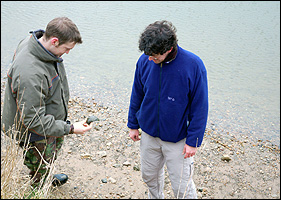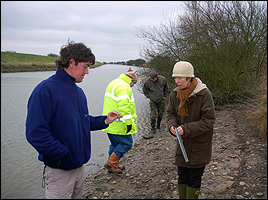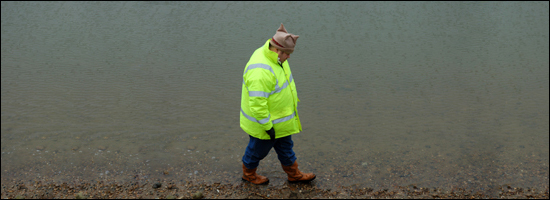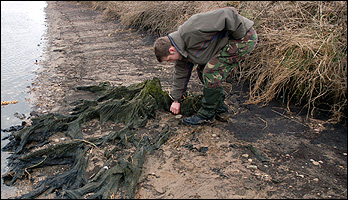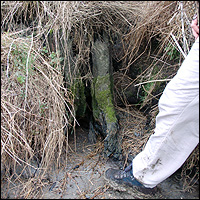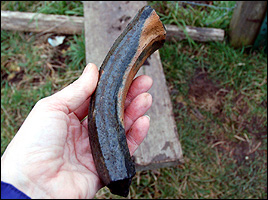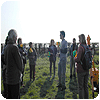










 |
||||||||
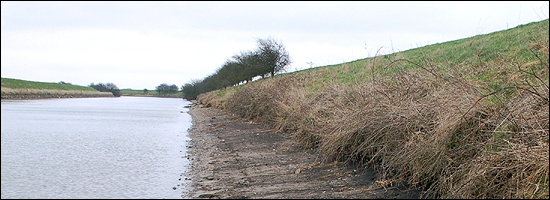 WAG indulges in a spot of ‘mud-larking’ ….. in late February?! |
||||||||
There was actually a serious side to this, as during a previous walk along the edge of the Witham a significant amount of pottery had been noticed and as this falls so very neatly within our study area, we thought that whilst the river levels are being kept low by the Environment Agency, that it would be a good time to go back and carry out a relatively thorough walkover survey of the Witham foreshore. By ‘foreshore’ we mean that section of exposed river bed between the waters edge and the artificially raised river bank. |
||||||||
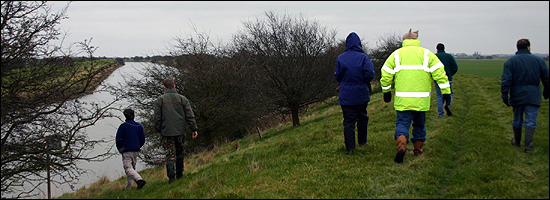 |
||||||||
A cold easterly wind made for less than ideal conditions, but we pressed on regardless. We were only able to walk on the exposed sections of foreshore; much has already been covered with stone as part of the Environment Agency’s erosion prevention work. |
||||||||
| ||||||||
The modern riverbank has been built up over the peats and alluvial deposits that have formed and been deposited within the Witham Valley. Where the river has washed away the bank side it is now exposing the peats, silts and other alluvial layers in section. Within these layers are the remains of trees that were once growing on the old land surface before it became much wetter. What we can see now are the tree stumps and their roots(below left), these have been preserved in the waterlogged conditions. In some cases (below right) some of the stumps within the bank section still stand several feet high. |
||||||||
| ||||||||
Large fragments (sherds) of pottery were found lying on the river foreshore. All were in relatively good condition and not heavily abraded; unlike pottery found on farmland, where the continual action of ploughing, turning the soil and exposing the pottery fragments to the elements leads to the sherd being broken into smaller pieces with a general ‘rounding off’ of the broken edges. In this case the fragments from the river foreshore showed very little wear at all; the broken edges were still relatively sharp. A preliminary study of the pottery fragments seems to indicate that most date from the Late Medieval (15th C) to Early Post Medieval (17th C) periods. Many of the sherds were decorated with a green or orange glaze. |
||||||||
| ||||||||
One large fragment of what appears to be roman pottery (see below) was also discovered partly buried in the sandy foreshore. It is probably from the base of a large jar and was the only find from this period made during the walkover – an erratic amongst the late medieval material. |
||||||||
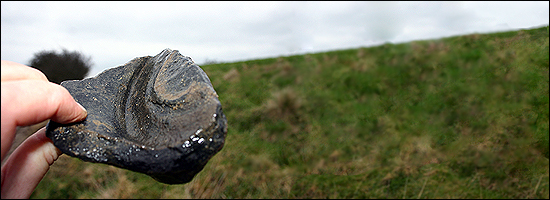 |
||||||||
At this stage we can only speculate as to how the pottery got there. As it was all found in a relatively concentrated area we think that it could be from a small settlement or settlements, which sat close to the side of the late medieval river channel. It is possible that these settlements may have been fisheries as others have been found along this part of the valley, however it should be understood that at this stage this is only a theory and more detailed field (or river!) work will need to be carried out before we can fully establish what exactly was happening along this stretch of the Witham during the late medieval period. |
||||||||
| ||||||||
With the survey over it was time to scramble up the steep bank for a group photo of those who had survived the inclement conditions before we headed back to the Tea Room at Washingborough to thaw by the fire and drink lashings of hot tea. |
||||||||
By Matt Vickers |
||||||||
v.4 'Rise of the Screen' |
||||||||
